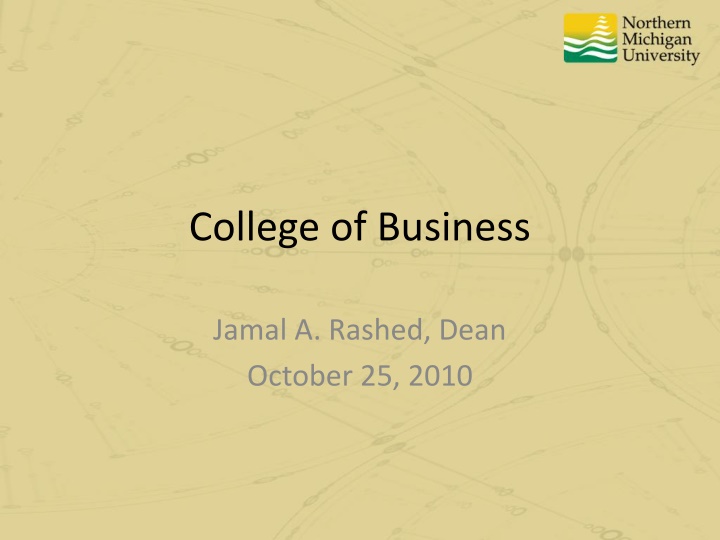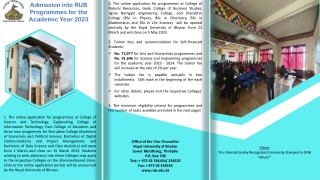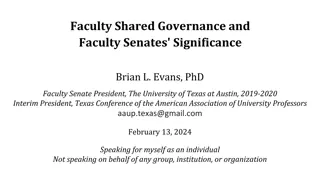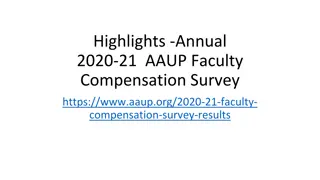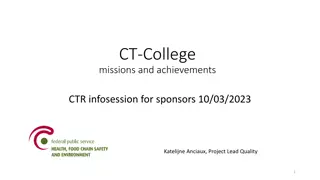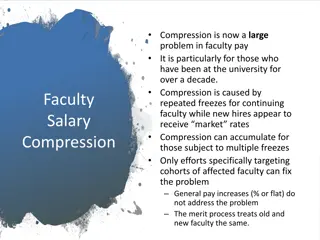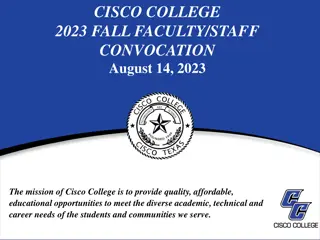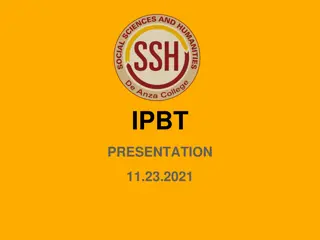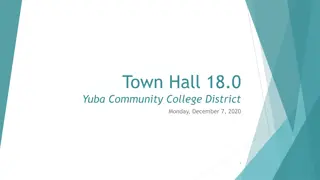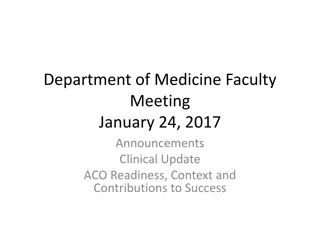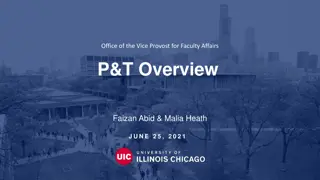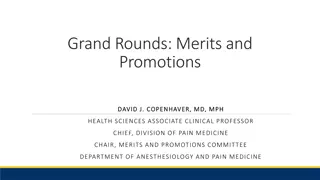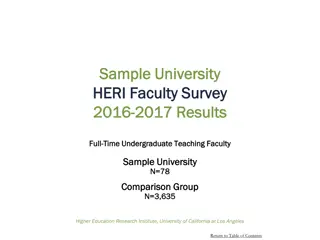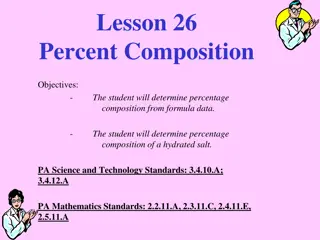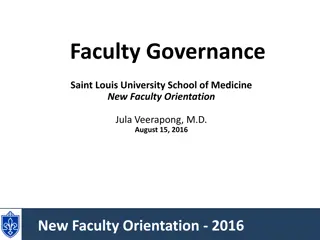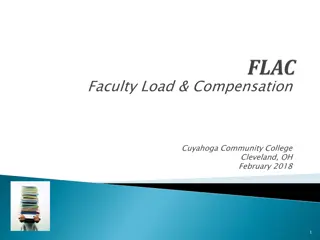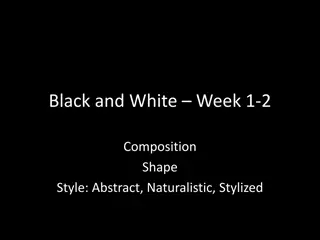College of Business Overview and Faculty Composition
The College of Business at Jamal A. Rashed, Dean, offers a comprehensive overview of its structure, enrollment, faculty composition, intellectual contributions, accreditation by AACSB, and adherence to Standard 9. Explore key details such as departmental structure, enrollment statistics, faculty distribution, intellectual contributions, and accreditation maintenance.
Uploaded on Mar 13, 2025 | 1 Views
Download Presentation

Please find below an Image/Link to download the presentation.
The content on the website is provided AS IS for your information and personal use only. It may not be sold, licensed, or shared on other websites without obtaining consent from the author.If you encounter any issues during the download, it is possible that the publisher has removed the file from their server.
You are allowed to download the files provided on this website for personal or commercial use, subject to the condition that they are used lawfully. All files are the property of their respective owners.
The content on the website is provided AS IS for your information and personal use only. It may not be sold, licensed, or shared on other websites without obtaining consent from the author.
E N D
Presentation Transcript
College of Business Jamal A. Rashed, Dean October 25, 2010
Departmental Structure At the present time, no separate departments Previous departmental structure Management, Marketing, and Computer Information Systems Accounting and Finance Office Systems and Business Education
Enrollment (833) Bachelor Accounting (175) Computer Information Systems (51) Entrepreneurship (57) Finance (75) Management (140) Marketing (106) Ski Area Management (13) Associate Computer Information Systems (20) General Business (41) Health Information Processing (32) Office Information Assistant (11) Certificate Office Services (2) MBA (20) Undeclared, etc. (90)
Faculty Composition 17 tenured Accounting (4) CIS (2/1.33) Entrepreneurship (1) Finance (2) Management (6) Marketing (2) 3 continuing contract CIS (1) Associate Degrees (2) 5 term Accounting (2) CIS (1) Finance (1) Management /Business Law (1) 4 tenure track CIS (1) Entrepreneurship (1) Finance (1) Marketing (1)
Intellectual Contributions In the last 5 years, the faculty have produced 248 research items, including: 68 articles in peer-reviewed journals 2 books (one with at least one revised edition) 1 book chapter 18 publications in peer-reviewed proceedings 150 paper presentations at peer reviewed academic conferences 9 faculty research seminars
Accreditation The College of Business is accredited by The Association to Advance Collegiate Schools of Business (AACSB). Maintenance of accreditation review every 5 years 21 Standards
AACSB Standard 9 The school maintains a faculty sufficient to provide stability and ongoing quality improvement for the instructional programs offered. The deployment of faculty resources reflects the mission and programs. Students in all programs, disciplines, and locations have the opportunity to receive instruction from appropriately qualified faculty.
To meet Standard 9 Restore one tenure-track marketing line Convert term finance line to a term marketing line
Hire adjuncts? Jeopardizes AACSB accreditation Identifying adequately prepared local professionals has been a challenge To replace 2 full time faculty positions with adjuncts would require 3+ individuals 3 new adjuncts would violate our accreditation standards
Marketing Program Presently 106 majors 3 FTE faculty 368 SCH per FTE 1104 total SCH 11 course offerings (6/11 MKT230) Bureau of Labor Statistics estimates: 14% growth in marketing managers 28% growth in marketing analysts
Marketing Program Presently 106 majors 3 FTE faculty 368 SCH per FTE 1104 total SCH 11 course offerings (6/11 MKT230) Fall 2007 119 majors 4 FTE faculty 367.8 SCH per FTE 1659 total SCH 14 course offerings (7/14 MKT230)
Factors MKT 230 is required of every business major. Non-business majors use MKT 230 and other MKT courses as required or elective courses. In order to fulfill MKT 230 demand, we are limited in our ability to offer electives. There may be a relationship between the decline in MKT electives and MKT enrollment.
Marketing Faculty Data Fall 07-10 2008 Winter 2009 Winter 2010 Winter Marketing 2007 Fall 2008 Fall 2009 Fall 2010 Fall # COB Faculty FTE 30 29.33 32 31.75 29 31.64 29.33 # MKT Faculty (FTE) 4 (4.51) 4 (3.75) 4 (4) 4 (3.92) 4 (4) 4 (3.92) 3 (3) # Courses 14 12 13 12 13 12 11 Total Credit Hours 54 45 52 47 52 47 44 SCH 1659 1346 1316 1323 1412 1205 1104 Majors 119 106 132 111 119 111 106 SCH per MKT FTE 367.8 358.9 329.0 337.5 353.0 307.4 368.0 SCH per COB FTE 333.1 317.5 315.4 302.0 328.7 318.9 327.1 Difference: MKT-COB Majors per faculty member 34.7 41.4 13.6 35.5 24.3 - 11.5 40.9 29.8 26.5 33.0 27.8 29.8 27.8 44.0
Convert FIN term to MKT term 2008 Winter 2009 Winter 2010 Winter Finance 2007 Fall 2008 Fall 2009 Fall 2010 Fall # COB Faculty FTE 30 29.33 32 31.75 29 31.64 29.33 # FIN Faculty (FTE) 3 (3.01) 3 (2.66) 4 (3.08) 4 (4.58) 4 (3.92) 4 (4.58) 4 (3.75) # Courses 9 9 9 14 11 11 9 Total Credit Hours 36 36 36 55 43 43 36 SCH 854 700 798 872 961 1129 1230 Majors 74 64 78 74 70 67 75 SCH per FIN FTE 283.7 263.2 259.1 190.4 245.2 246.5 328.0 SCH per COB FTE 333.1 317.5 315.4 302.0 328.7 318.9 327.1 Difference: FIN-COB - 49.4 - 54.3 - 56.3 - 111.6 - 83.5 - 72.4 0.09 Majors per faculty member 24.7 21.3 19.5 18.5 17.5 21.8 12.8
Our Priority Increase retention and recruitment of marketing majors and minors Meet AACSB standard by Restoring tenure-track marketing line Convert term finance line to a term marketing line Increase quality of marketing curriculum
Strategic Growth - MBA MBA enhancement One tenure-track faculty line to cover MBA expansion Area of expertise International Business & Health Care Administration
Strategic Growth - MBA NMU Road Map Innovation Goal Goal: An academic curriculum that balances successful programs with new offerings at the undergraduate and graduate level to meet the needs of students, as well as improve student career opportunities A1. Integrate global engagement and diversity learning experiences throughout the academic curriculum. A4. Explore and act upon opportunities to expand programs in nursing and allied health to meet the growing demand for professionals in health care and related fields. A5. Explore and act upon graduate programming (certificate, master s doctoral) in areas of recognized strengths, needs, and opportunities
International Business Integrate global and diversity learning experiences into the business curriculum (A1) Respond to increasing competition from peer business schools (LSSU-establishing int l business major; MTU-strong int l business emphasis in curriculum) Improve the level of preparation of our graduates Increase partnerships with programs outside the U.S.
Health Care Administration Marquette County is the health care hub of the U.P. Meets the growing demand for professionals in health care and related fields (A4) Government Bureau of Labor Statistics: Master s in health care administration is the standard credential for the field Projected that health care administration will grow 16% by 2018
The business of the health industry is approximately 17% of the US GDP (OECD Health Data 2009). This is up from 13.6% in 2000. A steady increase for the future is undeniable. There is a need for business professionals to lead and manage the industries supporting and involved in the health industry.
